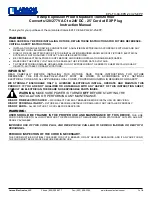
1. DESCRIPTION
The BA374C is an intrinsically safe 4/20mA loop
powered transmitter incorporating a large easy to
read display. The instrument may be programmed
on-site to accept most common thermocouples
and resistance thermometers, and will provide a
linear 4/20mA output proportional to temperature,
plus a display in
o
C or
o
F. Voltage inputs may be
scaled allowing the BA374C to display variables
other than temperature.
Optional alarms provide two galvanically isolated
solid state outputs which may be independently
programmed for high or low operation. For
installations in poorly illuminated areas an optional
display backlight is available.
The BA374C transmitter has been designed in
accordance with EN50014 & EN50020, and has
been issued with an EC-Type Examination
Certificate confirming compliance with the
European ATEX Directive 94/9/EC.
The BA374C transmitter is available in a glass
reinforced polyester (GRP), or an epoxy painted
aluminium enclosure, both provide IP66 protection.
Fig 1 Simplified block diagram
2. OPERATION
Fig 1 shows a simplified block diagram of the
transmitter. The input signal, which may be from a
thermocouple, resistance thermometer or a dc
voltage, is digitised and transferred to the
instrument processor via an optical isolator. The
processor scales the signal and for temperature
measurement applies linearisation using look-up
tables stored in permanent memory. The
resulting temperature is shown on the internal
display and controls the 4/20mA output current.
The transmitter and the optional alarms are
powered from the 4/20mA current loop, but the
optional display backlight requires a separate
supply.
Each time power is applied to the instrument,
initialisation is performed. After a short delay the
following display sequence occurs:
-1.8.8.8.8
Display test in which all
segments of the display
are activated for 2.5
seconds.
. . . .
For 1 second
0
For less than 0.5
seconds.
Input signal
Using calibration
displayed
information stored in
instrument memory.
2.1 Controls
All functions of the transmitter can be programmed
on-site via four push-buttons which are located
behind the enclosure cover - see Fig 5. In the
display mode i.e. when the transmitter is displaying
the input signal, these push-buttons have the
following functions. The 4/20mA output current is
not affected when these push-buttons are
operated, and when released, the input signal will
again be displayed.
Button
Function
Down
While this button is pushed the
transmitter will show the display
corresponding to a 4mA output.
Up
While this button is pushed the
transmitter will show the display
corresponding to a 20mA output.
For transmitters fitted with alarms
E
+
Up
While these buttons are pushed the
transmitter will display setpoint 1.
E
+
Down
While these buttons are pushed the
transmitter will display setpoint 2.
It is also possible to adjust the two alarm setpoints
from the display mode - see section 11.4
5
Содержание BA374C
Страница 1: ...BA374C Intrinsically safe field mounting indicating temperature transmitter Issue 5 3rd December 2003...
Страница 4: ...4...
Страница 11: ...11...
Страница 12: ...12...
Страница 24: ...24 Fig 13 Programme structure for optional alarms...






































